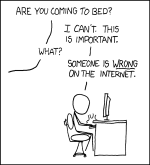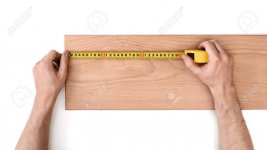I suggested that the Pass article would be sufficient.
What's the issue Nelson's article is nothing but ordinary engineering? If a speaker has a predominantly inductive impedance at high frequencies a large capacitive load can make some amplifies oscillate I have observed this. There is nothing here but ordinary R/L/C (and skin effect as a minor correction in some cases) design. No need to bring in any snake oil nonsense.
What's the issue Nelson's article is nothing but ordinary engineering?
Yes. It quite clearly illustrates how some 99.9% of the hifi world needs to be treated. But it also menations that there is a small segment that does not fit nicely into the mainstream. The subset under discussion AFAIC.
dave
Nope. What is the relevance of the comparison to capacitors used in crossovers?It was, IIRC, the next post so quoting is unneeded.
dave
In Nelson’s article on speaker wire i linked to above i believe he indicated he started seeing skin effect at 1kHz.
dave
Skin effect stars just above dc. The question is when does it become audible. The fraction of a db change in the above 10khz range will not matter.
Playing games again Dave? This is the post he was responding to:You seem lost Matt.
dave
For 12 feet of twisted CAT 5 (ie a 6’ cable) the Cirrus capacitance estimator suggests something like 3nF. That is a lot smaller than typically XO caps, is it enuff to cause oscillation? The amp execution would also play a significant role in its behaviour.
dave
May I make a suggestion at this point to the thread at large? The phrase 'let it go' is one well worth remembering. 😉
As a mild observation though, in good crossover design practice, a large direct capacitive shunt to ground is always better avoided, even after an inductor.
Last edited:
When the music reaches you, it will have already passed through many hundreds of thousands of metres of plain old copper wire.
If you are really able to detect a change that 5 metres of magical cable makes, in a blind comparison against plain copper cable; then yes it will be worthwhile purchasing cables made of unobtanium.
Kevin
If you are really able to detect a change that 5 metres of magical cable makes, in a blind comparison against plain copper cable; then yes it will be worthwhile purchasing cables made of unobtanium.
Kevin
Nope. What is the relevance of the comparison to capacitors used in crossovers?
You are lost.
What JM was saying is that i was wrong in thinking that the wire capacitance was in series with the 1st series XO cap.
He is right. The capacitance is shunted across the amplifier, but it is not as simple as he makes out (otherwise — based on Nelson’s measurements — fatter cable would short circuit at lower frequencies).
BTW an advantage a current amp is that it does not care if you short the output terminals.
Nelson’s paper shows in a clear way what a speaker cable looks like and how they measure. And describes what you would look for in the 99.9% of situations where one has a speaker that assumes a low output impedance amplifier, takes little care of what the impedance looks like, and an amplifier that has to be a low output impedance because the speakers thay need to drive have impedance curves all over the map. Sort of like a Ouroboros.
dave
I should also mention that i don’t much do passive XOs. Either none, or before the amplifiers mostly. And if its anything more than something simple fixing electronics means taking it to Daniel.
dave
dave
As a mild observation though, in good crossover design practice, a large direct capacitive shunt to ground is always better avoided, even after an inductor.
Hi Scoot, can you precise and why?, is it because it has a small ESR which leaks some power in the ground?
what other choice do you have if you build a 2n order xo to filter a woofer? some 150uf is typical.
What would you consider and 'large' capacitance? 2mf ?
All this over-thinking" about the resulting sound"..........
I just listen to the music, and if it sounds nice, that's all that matters.
I just listen to the music, and if it sounds nice, that's all that matters.
Can cryo treatment of solid core cable such as CAT6 improve its audio performance when used as speaker connect? Of course it can!
Double-blind listening tests have conclusively demonstrated an n-th degree of detail improvement is attainable in a well-balanced system. Achieving such a state is called cryptalgesia, a situation that is more readily achievable with an application of cryogenic multi-phase gel to the speaker cones and cryptonic power gel to the ear lobes of the listeners. And there is a clear physical explanation for the effect.
At the Plank length, c. 10^(-35)m, the effects of quantum vibration reflect the observed spectrum, with a small cosmological constant, containing dark matter and a plausible explanation for both cosmic inflation and, critically in the current context, the vibrational non-linearity that can be shown to be unstable when subjected to arbitrarily small finite-amplitude perturbations. Crucially, the AdS/CFT duality has a clear parallel familiar to DIYA members in the form of the dual natures of time-domain and frequency-domain realities and the transformative abilities of Laplace-derived enquiries into the AdS/CFT and other dualities arising from our investigations.
The importance of the duality becomes clear when one considers the connections between the worldvolumes of p-branes, which can be of the form of e-strings, a-strings, d-strings or g-strings. A p-brane etches out its existence as a (p+1)-dimensional volume, and there exists the possibility of interaction between the [{p+1}-2i] dimension and the Aegidius-Kriton manifold. This is not purely a conceptual or theoretical interaction, but is a real event in a reality which can affect the more familiar [(4+i)^e]-dimensional spacetime.
Since, in bosonic string theory, spacetime is 26-dimensional, small disturbances in the quintic Aegidius-Kriton manifold can feed through to the quantum-level vibrations, which in turn affect the transmission of detail from the amplifier to the loudspeaker. Cryo treatment offers an effective and cost effective means to control and reduce the Aegidius-Kritonic disturbances and associated distortions.
Double-blind listening tests have conclusively demonstrated an n-th degree of detail improvement is attainable in a well-balanced system. Achieving such a state is called cryptalgesia, a situation that is more readily achievable with an application of cryogenic multi-phase gel to the speaker cones and cryptonic power gel to the ear lobes of the listeners. And there is a clear physical explanation for the effect.
At the Plank length, c. 10^(-35)m, the effects of quantum vibration reflect the observed spectrum, with a small cosmological constant, containing dark matter and a plausible explanation for both cosmic inflation and, critically in the current context, the vibrational non-linearity that can be shown to be unstable when subjected to arbitrarily small finite-amplitude perturbations. Crucially, the AdS/CFT duality has a clear parallel familiar to DIYA members in the form of the dual natures of time-domain and frequency-domain realities and the transformative abilities of Laplace-derived enquiries into the AdS/CFT and other dualities arising from our investigations.
The importance of the duality becomes clear when one considers the connections between the worldvolumes of p-branes, which can be of the form of e-strings, a-strings, d-strings or g-strings. A p-brane etches out its existence as a (p+1)-dimensional volume, and there exists the possibility of interaction between the [{p+1}-2i] dimension and the Aegidius-Kriton manifold. This is not purely a conceptual or theoretical interaction, but is a real event in a reality which can affect the more familiar [(4+i)^e]-dimensional spacetime.
Since, in bosonic string theory, spacetime is 26-dimensional, small disturbances in the quintic Aegidius-Kriton manifold can feed through to the quantum-level vibrations, which in turn affect the transmission of detail from the amplifier to the loudspeaker. Cryo treatment offers an effective and cost effective means to control and reduce the Aegidius-Kritonic disturbances and associated distortions.
Ludus,
I would tend to agree, but only to a point. The quantum physics break down when properly applied. That said, like all things string, adding another dimension will help the math work, so let’s call it 27 dimensions, make it 28 to account for stereo imaging (maths yet to be discovered, but 27 won’t do it).
I would tend to agree, but only to a point. The quantum physics break down when properly applied. That said, like all things string, adding another dimension will help the math work, so let’s call it 27 dimensions, make it 28 to account for stereo imaging (maths yet to be discovered, but 27 won’t do it).
Plank lengths tend to be longer in my experience, but thanks for an amusing thesis! 🙂At the Plank length, c. 10^(-35)m
Attachments
Yes. It quite clearly illustrates how some 99.9% of the hifi world needs to be treated. But it also menations that there is a small segment that does not fit nicely into the mainstream. The subset under discussion AFAIC.
That 0.1% has been quantified, sometimes it's 5% or what ever? Inquiring minds what to know, is it really 0.01% or less or who knows?
- Status
- Not open for further replies.
- Home
- Member Areas
- The Lounge
- Questions about speaker wire's? What forum do I post it on?

